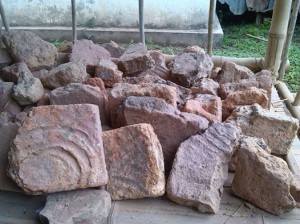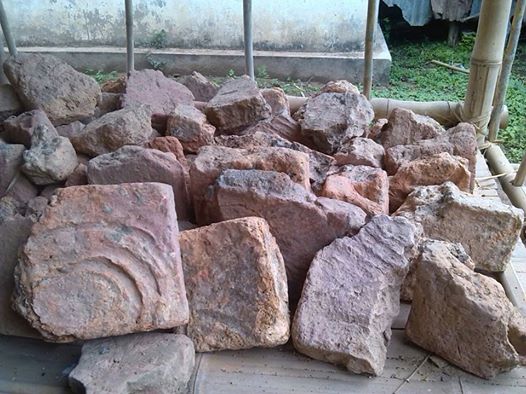
“The main bricks on display [will be] bricks with signs of finger scratches on the surface. Some bricks remain as original, but some [which] are half-broken or broken into three pieces will be on display also,” said U San Win.
U San Win explains that bricks found on the brick hill in the area surrounding the Pawtaymuusein Temple, in Rangoon Division, are the same as bricks from the Pyuu Era found in central Burma, as well as bricks found in the Winka area of Suvannabhumi City.
“We have to continue doing research on the hill where [the] bricks [have been] found”, said U San Win, “We have [received a] permit from [the] Historical Research Department. We have planned to open the museum in November [2014], around the end of the rainy season.”
The museum’s main display will include bricks discovered in the hill near the entrance of the Partaumuusein Temple, while other kinds of bricks from different eras, found in nearby areas, will be displayed for comparison.
U San Win explains that the goal will be to “prove that over 2500 years ago, Mon people built the Shwedagon Pagoda with this kind of brick. But, due to generations of kings that have decorated the pagoda, it is impossible to find the original bricks.”
“Nowadays, the covered stairway of the Shwedagon Pagoda is decorated with aluminum”, U San Win points out.
The museum aims to prove that the Shwedagon Pagoda was built with this kind of brick, although no one knows the exact date the pagoda was built, as it was built by Mon people who did not have a written language at that point in history.
“Before, U Chit San Win said the bricks with this sign of finger scratches were handmade by the Pyu [people]. But now, since this kind of brick is also found in the area surrounding the ancient Suvannabhumi [City] as well as the entrance to the Pawtaymuusein Temple, it is telling that those places were not [the] residence of Pyu people, but Mon,” said Mon historical researcher, Nai Maung Toe.
Nai Maung Toe further notes that the Pyu and Mon had the same knowledge of brick-making. Thus, to show firm evidence of Mon historical heritage, the museum should be extended to include displays of Mon ancient bricks.
With support from the Mon Literature and Culture Association in Rangoon, along with U San Win’s own finances and financial support from a friend, U San Win built the brick museum with a bamboo hut which has a palm-leaf thatched roof.
Recently, discovered bricks and other ancient materials from the ancient Suvarnabhumi City area were presented in a one-week display at the Mon State Heritage Research Museum in the Moulmein capital of Mon State.

